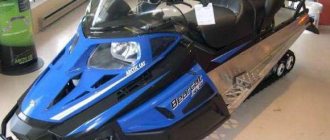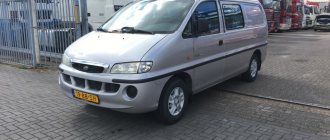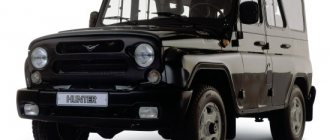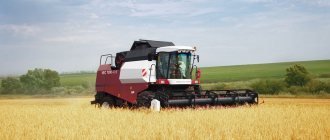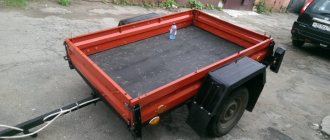Author: Oleg
24 August 2016 13:11
Tags: vector gases groove
18845
15
Following the new GAZON, GAZelle and Ural, united under the “NEXT” brand, a completely new Vector NEXT bus was revealed, which is assembled at the facilities of Nizhny Novgorod and the Pavlovsk Bus Plant.
0
Source:
See all photos in the gallery
Products from the city of Pavlovo have long become a common means of transport for city residents - the legendary “PAZIKS” are almost the most common type of public transport in the vast expanses of our homeland.
0
Source:
The easily recognizable profile of the bus can be seen both on city lines and on suburban routes. Put on the assembly line back in 1989, the hard worker PAZ-3205 is still in production with minor modifications.
×
Characteristic
What kind of car is this? "GAZ Vector Next" is a bus designed for suburban and urban transportation. It was first presented to the public in 2015 at the Moscow Crocus Expo exhibition.
Serial production started a year later. The machine is available in several modifications. So, there are versions for 7.1, 7.6 and 8.5 meters. What is noteworthy is that the model was developed at the Gorky Automobile Plant, but is produced at the Pavlovsk Automobile Plant. “GAZ Vector Next” is designed to replace the obsolete grooves of the 3205 model, which have been produced since the times of the USSR.
Design
The design can rightfully be called successful. Finally, the Russian manufacturer has reached the European level and can compete with the likes of Scania and others. The appearance of the car deserves respect. Compared to PAZ, this is a huge step forward. There is nothing left of PAZ here. The car is built on the new GAZon Next platform and has its own unique design. The car uses modern optics, fog lights and a large windshield that extends all the way to the wide chrome radiator grille. The mirrors on the GAZ Vector Next car are painted in body color and placed on top - like on all modern buses. As for the quality of body painting, the manufacturer provides a ten-year guarantee for protection against corrosion. By the way, its lower part and roof are made of plastic.
Dimensions
As for the dimensions, the width of the GAZ Vector Next bus is 2.45 meters, the height is 2.9 meters. But the length may be different. As we said earlier, there are modifications for 7.1, 7.6 and 8.5 meters.
The bus is highly maneuverable. Even with the longest body, it can maneuver through narrow streets. The wheelbase of the car is almost 4 meters. Naturally, there is no talk of any off-road conditions here. This is a purely city bus.
"Vector" inside
The driver's seat has a rotated panel and a multifunction steering wheel. By the way, the steering wheel was borrowed from the GAZelle “Next”. The center console is quite simple - there are buttons for controlling the stove, doors and a small multimedia display.
By the way, the deflectors were also taken from the GAZelle “Next”. Both have a good location of controls, a comfortable seat and high-quality sound insulation. Compared to PAZik, this is a real breakthrough. By the way, the engine is partially located in the cabin. It is accessed through a plastic decorative cover. As for the seats for passengers, everything here is also thought out and ergonomic - from the landing to the seats. By the way, the latter can be equipped with seat belts.
Of course, the seats themselves will already have more pronounced lateral support. The manufacturer offers factory tinted glass. But the ventilation system, unfortunately, is only of the natural type (there is a mechanical hatch in the roof). There are also three heaters in the cabin, which cope well with Russian winters. As an option, the Russian GAZ Vector Next bus can be equipped with air conditioning and a video surveillance system. The cabin can accommodate from 17 to 25 people, depending on the length of the body. Including standing room, it seats up to 53 people. For this purpose, there are convenient handrails and handles on the backs of the seats. The cabin is quite comfortable. The car can be used not only on city routes, but also over longer distances.
Heroic horse!
Well, what has changed for the driver in this case? Yes all!
You can get into the cabin, as before, through a personal door on the left side or directly from the cabin. The first option is convenient - there is only one step, at an acceptable height and at the same time covered by a door. For ease of entry, there is both a traditional handle on the counter and a handrail on the door itself - choose whichever is more convenient.
However, despite the fact that the factory workers insist on the priority of the “normal” input, I also tested the second option. Frankly speaking, shortening your way in this way is not only inconvenient, but also impractical - you are unlikely to be able to sit in a chair without getting it dirty with your shoes. So - through the door, please.
The driver's workplace has noticeably improved. The right angles on the front panel and the engine compartment cover have disappeared. The panel itself not only acquired a rounded shape, but also turned towards the driver, following the example of all modern models. In addition, judging by the number of plugs, there are much more “rich” configurations in the plans. In principle, everything is visible in the photo, but I’ll add that using the panel has become more convenient - you have to reach less.
The definite advantages include good visibility, good exterior mirrors and workplace ergonomics, which deserve a “very good” rating. The only thing is that the location of the interior mirror in the upper right corner of the cabin requires some getting used to, but these are nuances.
But I would consider the sound insulation of the engine compartment to be a serious disadvantage. Yes, compared to its predecessors, the cabin and interior have become quieter. Yes, you can say as much as you like that all standards have been met. However, you really can’t envy the driver. Even those who defend the honor of the brand reluctantly admit that by the end of an 8-hour shift, the head is simply buzzing, and yet the shift can last 10 hours. Perhaps there are some objective reasons why the rattling of a diesel engine hurts the ears in a brand new bus, but for those who spend years of their life behind the steering wheel, this does not make it any easier.
But I was pleased with the dynamics of the car and its handling. The machine passes the snake perfectly and maintains its trajectory even at speeds higher than the workers. At first it seems that the bus is too heavy to accelerate, but looking at the speedometer, you understand that 60 km/h is not a speed for cars and LCVs, but for a city bus it is already a reasonably acceptable limit.
Now I personally will wait for automatic transmission to come to the list of options. You quickly get used to good things, and even the clear movements of the gearbox lever do not save the situation; in city traffic jams, moving with a manual transmission is agony for both drivers and passengers.
There were no questions about everything else. An excellent chassis for suburban and intracity traffic within the framework of the “budget concept”. By the way, as a passenger it feels like it won’t let you down even in our outback, where “roads” should only be written in quotation marks. The main thing to remember is that there are not “oak” all-absorbing springs below, but a gentle air suspension...
"GAZ Vector Next": technical characteristics
An engine from the Yaroslavl Motor Plant is used as a power unit. As you know, gasoline engines are not made in Yaroslavl. Therefore, the GAZ Vector Next is equipped with a 4.4-liter in-line 4-cylinder diesel engine. The engine features a direct injection system and oil-cooled turbocharging. It also uses an exhaust gas recirculation system. Previously, it was equipped with GAZ trucks. In reviews, owners say that this system is not very reliable. The warning light on the instrument panel often lights up, and the engine starts to run erratically. The essence of this system is quite simple - all the dirt that goes into the manifold is returned back to the intake. Thus, excess soot is re-burned in the cylinders. This has a positive effect on the environmental friendliness of the exhaust, but is very harmful to the engine. In the reviews, the owners say that for normal operation, they have to “cut out” the software of this system and install plugs in the motor.
But let's continue about our Yaroslavl motor. The environmental exhaust standard is Euro 5 (thanks to the recirculation system). The maximum power of the Yaroslavl engine is 150 horsepower. Torque – 500 Nm at 1500 rpm. The engine has a simple cast iron block and has a long service life. However, due to the introduction of technological innovations, problems may occur with it. The YaMZ engine is paired with a C40R13 manual gearbox produced by the Gorky Automobile Plant. The transmission was previously installed on LAWNs, so it has long proven its reliability. There are no electronics in the transmission - all shifts are made mechanically. The average fuel consumption of the GAZ Vector Next bus is 20 liters per hundred kilometers. Acceleration to hundreds was not regulated by the manufacturer. But the maximum speed is exactly 100 kilometers per hour. In the future, the manufacturer plans to expand the range of power units to include engines running on gas engine fuel.
The most humane in the world: test drive of the Vector Next bus
All new
Either I’m more used to old Soviet buses, or something else, but driving the Vector Next really made me very happy.
It must be admitted that a gigantic step forward has been made. The layout of the bus is classic: a semi-supporting carriage body with a front-mounted engine. The bus is based on a GAZ chassis with GAZ units, which we will discuss below. In the meantime, let’s pay attention to the body: where are the crooked rusty sides with paint stains? But there are none. PAZ is no longer the same, he is losing his face, I will report to you. PAZ succumbed to the influences of fashion, sold himself to technological progress and embarked on the path of development. We, citizens, no longer have a real PAZ. It got to the point where Vector Next is galvanized and painted with metallic paint. And the masks, roof side panels, lower side panels and hatches are made of plastic. And they do it, in my opinion, very nicely. However, this can be seen in the photographs. I’ll just add that progress has gone so far that manufacturers guarantee the life of the body for at least ten years. The indicator is not bad, considering that buses are not locked into pits during the winter.
Engine
YaMZ-53443 4.4 l, 150 hp.
In general, the design of the bus is interesting, and here they were able to finally not only make something beautiful, but also practical. For example, pay attention to the side mirrors. Previously, different mirrors were the subject of fetish exclusively for owners of Mercedes in the back of the W124, but now here they are - asymmetrical mirrors on a bus. As we will find out later, this is very convenient.
Now a few words about the aggregate base. The bus engine is Yaroslavl diesel YaMZ-53443. We are already familiar with this engine from other GAZ Group vehicles, but repetition is the mother of learning, so let us remind you: volume - 4.433 liters, power - 150 hp. at 2,300 rpm, maximum torque - 490 Nm at 1,200 - 1,600 rpm. The engine is located longitudinally in front. Of course, it is strangled... sorry, it complies with Euro-5 standards. Well, the most important thing is the calculation resource. I see how now all the carriers who read our reviews and still don’t know anything about Vector Next are holding their breath: 700 thousand kilometers. So that.
Curb weight weight of the bus
6,650 kg
Now let's dump out all the necessary boring numbers and get on the bus. So, let's see.
The external dimensions of the bus are small: 7,645 x 2,445 x 2,915 millimeters, the wheelbase is 3,800. But the ceiling height is sufficient, 1,950 mm, and thanks to the relatively modest base, the turning radius is also very pleasing - only seven meters. The curb weight of the bus is 6,650 kg, technically permissible - 10,050 kg. The weight will be distributed along the axles as follows: 3,500 kg on the front axle, 6,550 on the rear axle.
Of course, there were some imported components. For example, the integral-type steering mechanism with hydraulic booster is ZF, the telescopic steering column is CSA, the clutch is Sachs (ZF) with pneumatic hydraulic booster. But the gearbox is domestic - five-speed manual GAZ C40R13.
Transmission
manual five-speed GAZ C40R13
The Wabco pneumatic brake system is equipped with everything expected in the twenty-first century: ABS, ASR and EBD systems. Of course, the brakes are disc (although until recently this was wild on domestic trucks, and not on trucks either, to be honest).
Both front and rear suspensions have anti-roll bars. The front suspension is dependent, leaf spring, the rear is also dependent, but pneumatic. By the way, the shock absorbers are Tenneco.
Now let’s go inside the bus and evaluate its interior.
25+1=41
Of course, I understand that we are all drivers, and we are ready to ride the bus only in a state of extreme intoxication or to get our car serviced. But let’s be objective: the most important thing in public transport is the comfort of passengers, and the driver, as usual, is secondary. Therefore, first we will sit in the passenger seats.
Vector Next is a fashionable guy, but you can’t say that he has a low gender. And yet, it’s convenient to enter; you don’t have to climb anywhere. The sufficient width of the door of 650 mm allows even such a well-fed guy like me to pass through easily.
The test bus was an intercity version with twenty-five seats in the cabin and one next to the driver. There are 41 seats in total, including standing ones. And I have concerns that sitting for a long time will not be very comfortable. However, this needs to be verified in practice, but the short test did not suggest such a possibility (probably fortunately). But overall, everything looks decent inside. At least until no one scribbled “Sasha + Masha = L” on the panels and signed this swear word.
Let's move to the driver's seat.
At first glance, the interior is quite dull. Gray plastic, everything looks a little rough and overly utilitarian. But God bless him, maybe the bus doesn’t need more.
It took me a while to get comfortable in the driver’s seat. The angle of the pillow seems to hint that you need to hold on to the steering wheel tightly, otherwise you will slide under the panel. The problem is solved by adjustments that are not too clear and unambiguous. In general, if there is only one driver, there are no problems, set it and forget it. But if they change, the setup takes a lot of time and is not very convenient. Although, maybe I’m wrong (but it’s unlikely).
The dashboard is a standard “lawn” one, about which more has already been said than about the mutual love between a man and a woman and between the 1.4 CAXA engine and engine oil. Spare me this repetition; let’s better pay attention to the specifics.
1 / 6
2 / 6
3 / 6
4 / 6
5 / 6
6 / 6
Turning the right side of the panel towards the driver is a bus classic, and it is convenient. The same goes for the location of the gearshift lever and parking brake. In my opinion, they are more convenient to use here than on trucks related to the Vector.
Now let's launch the Yaroslavl monster next to the driver and see how these miracles of technology behave on the road.
I listen to our breathing...
Remember, Butusov once sang how he listens to someone’s breathing and is surprised that it is the same for two? So I was surprised: my breathing was not muffled by the roar of a nearby diesel engine. They did a very good job on sound insulation, and it's obvious. Maybe this is due to the Vibracoustic engine mounts. In a word, it's quiet here.
Now we remove the car from the parking brake. Its lever is located just under the right hand, I didn’t even have to look for it. Depress the clutch and engage the gear.
Let’s be honest: I don’t like domestic cars, including trucks. And I don't like buses either. For example, because there is an unpredictable clutch, wild air brakes, an uncomfortable steering wheel and unclear gearboxes. Therefore, I express my gratitude to Vector: he was able to convince me that PAZ can do something good. The clarity of the gearbox operation is extremely unexpected (I wonder how long its backstage will last?), the softness and adequacy of the clutch pedal are beyond praise. Even a simple steering wheel without all these castings and chord cuts (just kidding, they don’t exist on commercial vehicles) is very comfortable. True, on a straight line it stands at a slight angle, but we will consider this a proprietary feature of a particular specimen.
I had a great opportunity to test the driving performance of the bus on the famous Nizhny Novgorod Ring - a track for competitions in automobile circuit racing and road-circuit motorcycle racing. There is no place to accelerate on a bus, there are too many turns, and the bus is not a racing car, and certainly not a motorcycle. And the organizers spared no expense on cones for maneuvering. But on such a road it is the best possible way to test the maneuverability of the bus. So what do we have?
First of all, great review. The glazing line is low, and thanks to the bevels on the doors, there are practically no blind spots, which are very annoying on old domestic buses. The mirrors are also very well located: you can see not only what is behind and on the sides, but also everything that is happening in the cabin. It is almost impossible not to notice a passenger entering or leaving the door.
There is practically no roll when cornering, and the bus passes through asphalt joints almost unnoticed even when empty.
In general, driving a Vector is very similar to driving a passenger car, albeit a very large one. Acceptable effort on the steering wheel, a soft and adequate clutch pedal, precise operation of the gearbox - all this is somewhat unexpected on the PAZ. Even 4.2 turns of the steering wheel from lock to lock is also pleasant.
I won’t evaluate the dynamics; for an objective assessment, you need to seat about 20 people here. On an empty bus, of course, there are no problems with it.
It is impossible not to note the elasticity of the engine, which is not very typical of diesel engines. There is no need to change gears too often, and I never got to fifth. Apparently, it will be useful mainly on the highway.
What else can I say?
Of course, a full impression can be made only after experience of long-term operation in urban conditions: there are too many nuances in the operation of the bus. This includes the adequacy of ABS at icy stops, and the ability to then move from there without blocking (here you will need to evaluate the work of ASR, which cannot be done on clean asphalt). But overall, the Vector brought positive emotions and seems to be a truly “humane” bus. The driver's workplace is especially pleasing. Time will tell how passengers and carriers will evaluate it.
Chassis
The bus has a similar platform to the GAZon Next truck. This is not surprising, because the old grooves were also built on the basis of LAWNs. However, here on this bus the suspension has been slightly upgraded. The front uses a spring beam with a transverse stabilizer, but the rear has a full air suspension. The body itself is a semi-supporting structure. The steering system is of an integral type, supplemented by a hydraulic booster. The brakes are pneumatic, from the Belgian company Wabco. Reviews say that this system is very reliable. Disc mechanisms are used at the front and rear. The brakes are also equipped with ABS sensors and have automatic clearance adjustment.
The PAZ “Vector Next” bus received the “Best Bus of the Year” award. Reasonable cost, low maintenance, good maneuverability, extended service life of the body and components - all this is about a multifunctional bus that can operate both in the city and in the suburbs.
The exterior and interior correspond to modern trends. The latest materials and components are used in the production of the bus.
A bus in the “Accessible Environment” variation is best suited for routes around the city with a small flow of passengers. A low-floor seat in the rear of the bus, an enlarged door passage, an enlarged platform for standing passengers with space for people with limited mobility, a mechanical ramp - all passengers will travel in comfort and safety.
You can find a brief overview of the bus at this link.
We can also organize a viewing and test drive of a bus especially for you.
For any questions, you can call 8-800-200-94-93 (free call).
| Body type | Semi-supporting; carriage layout |
| Curb weight/technically permissible weight, kg | 6120/10050 |
| Load on front/rear axle based on technically permissible weight, kg | 3500/6550 |
| Total number of seats (including landing seats) | 19+1 / 52 |
| Fuel tank capacity, l | 95 |
| Body life, years | 10 |
| Wheel formula | 4x2 |
| Length/Width/Height, mm | 7645 / 2445 / 2915 |
| Base, mm | 3800 |
| Number/width of doors, mm | 1 (650mm) + 1 (900mm) |
| Min. Turning radius, m | 7,5 |
| Chassis | produced by GAZ |
| Steering gear | With power steering |
| Brake system | Brakes – disc with automatic clearance adjustment; pneumatic with ABS |
| Steering column | with telescopic steering shaft, equipped with ignition switch with anti-theft device, steering column turn switches, high/low beam switching, windshield wipers, washer and sound signals, hazard warning button |
| Suspension | front - dependent, leaf spring with anti-roll bar; rear - dependent, on two longitudinal and one transverse levers, with pneumatic elastic elements, with hydraulic telescopic shock absorbers and a stabilizer bar with a body position control system |
| Ventilation | natural, through vents in the side windows and hatches in the roof |
| Heating system | independent autonomous liquid pre-heater and 3 cabin heaters |
| Bus glazing | glued, colorless |
| Tires | 245/70 R19.5 |
| checkpoint | Manual transmission: C40 R 13, produced by GAZ; Automatic transmission Allison/GAZ |
| Maximum speed, km/h | 100 |
| Engine (diesel) | YaMZ-53423 (with EGR recirculation system) |
| Number and arrangement of cylinders | 4R |
| Environmental safety standards | EURO-5 |
| Working volume, l | 4,43 |
| Engine power, kW (hp) / min | 124.2 (168.9 hp) at 2300 min -1 |
| Max. torque, Nm/min | 597 Nm at 1200…1600 min -1 |
| Engine location | Longitudinal, anterior |
| Warranty | 36 months or 150 thousand km |
| Additional options | Air conditioning, video surveillance system with DVR, fire extinguishing system, electronic route indicators, digital tachograph, Granit-Navigator 2.07 user terminal (GLONASS/GPS), various seat options, tinted double-glazed windows, metallic body paint. |
Cost, equipment
The starting price for the Russian GAZ Vector Next bus in 2017 is 2 million 622 thousand rubles. As an option, the car can be equipped with:
- Autonomous preheater.
- Air conditioning.
- Window tinting.
- Electronic route indicators.
- Metallic body paint.
- Luggage shelves.
- Seats with seat belts for passengers.
- Digital tachograph (in case of using a bus on interregional flights).
- Fire extinguishing system.
- Glonass navigation system.
- Video surveillance and recorder.
In the maximum version, the cost reaches three million rubles.
The branded GAZ deer now appears on the false radiator grille of the new product.
0
Source:
The bus is equipped with a 4-cylinder, 150-horsepower YaMZ-53443 turbodiesel engine of Euro-5 standard. GAZon also received the transmission, suspension, chassis, and some interior elements.
0
Source:
And in 2022, an engine running on liquefied natural gas should appear in the lineup. The assembly of the new bus takes place according to a two-stage scheme: a self-propelled chassis equipped with a temporary seat for transportation comes off the assembly line in Nizhny Novgorod, and already 70 kilometers from GAZ the bus takes on its finished form.
0
Source:
The model range includes several variants of the Vector's interior, with a capacity of 17 to 25 seats. And the total “passport” capacity is up to 70 people. The length, depending on the capacity, will vary from 7 to 9 meters.

